Wherever you live, if you want to attract bees to pollinate your garden or you want to add more butterfly plants to your yard, you can’t find a better plant than buckwheat (Eriogonum) — or the many varieties available today. I just returned from a favorite walk, which winds through a neighborhood of large lots, most edged with large stands of native plants. The bees were busy on the California buckwheat back in April and they were busy on the same plants this late August day.
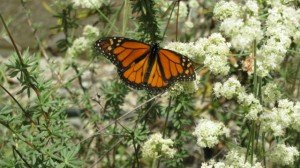
Before I list my favorite buckwheats here in So California, here is what’s great about them.
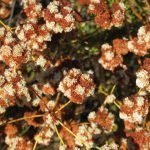
Color – Most native buckwheats have small green leaves, although some varieties have grey leaves and larger foliage. Pink to white flowers in the spring, turning to rust summer through the beginning of winter. You’ll want to wait til the flowers turn their pretty rusty color before trimming them off.
Plant characteristics and habitat value – Called ‘pillars of the plant community,’ buckwheats are important plants for bees, butterflies and all insects. Most every critter, except hummingbirds, love it. Important nectar for butterflies and all types of bees and other bugs. The seeds feed goldfinches and other seed-eaters, while the bushtits and other insect-eaters will become daily visitors.

Where to plant – Ours does well in full sun but part shade inland works well. As with all natives, fall through winter are the best times to plant natives.
My Favorites: St. Catherine’s Lace (Eriogonum giganteum) is large (4 feet) with larger gray foliage and gorgeous pinkish white flowers
Santa Cruz Island Buckwheat– Compact, two foot buckwheat native to the Channel Islands. Gray foliage with flowers that last from summer to winter. Great for dried flower arrangements. Two of our three did well in full-sun but part-shade would be better in the hot interior inland. Best with some supplemental water in the summer – but not too much, we lost one to overwatering.
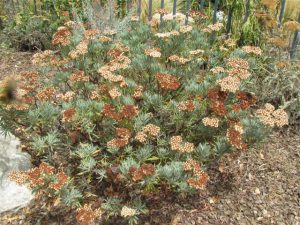
California buckwheat – And there’s nothing like the basic California buckwheat or its lower growing hybrids. Offers non-stop food for the bees and butterflies and flowers that slowly change from white to rust. After about six years, one of our large low-growing varieties became a ladybug nursery. (see photo below.)
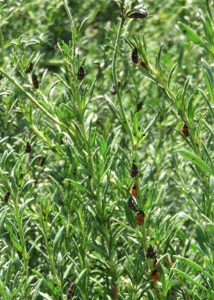
Others: Among the numerous varieties to consider, one is the rare Saffron buckwheat (eriogonum crocatum) for woolly white leaves and dainty yellow flower that turn
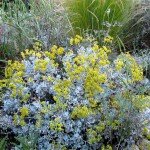
cinnamon brown. Best in some shade and regular water inland, prefers clay soil.
Linda Richards is a Redlands Horticulture and Improvement Society member, and writes a nature blog at www.ifnaturecouldtlak.com
How do you know if they died from overwatering? My Santa Cruz buckwheat plant just completely dried up. Is that from overwatering? I water every other day for 10 min. The plant is in sun half the day.
That does seem too often too me. Natives can get fungus diseases from watering too much in the hot weather. And with it in the sun half the day, natives wouldn’t need that much. Might want to check with Las Pilitas or Tree of Life Nursery to get their view. We watered ours once weekly (deeply) the first year, now 3 years later we’re down to once a month or twice monthly.